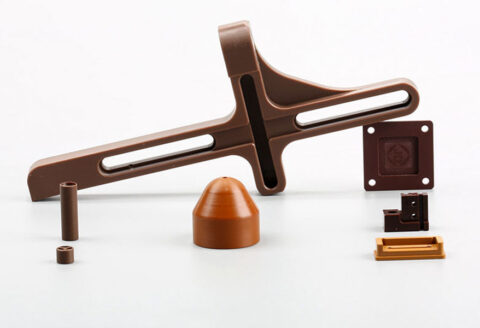The crystallinity and crystal form of crystalline plastic affect the physical and mechanical properties of the product. If the cooling rate during molding is slow, it is conducive to the progress of crystallization and can increase the degree of crystallinity. Therefore, it is extremely important to control the mold temperature to obtain products with excellent mechanical properties and good surface gloss.
In order to make the cooling rate slow in order to fully crystallize, the mold temperature must be increased, but the molding cycle will inevitably be prolonged. The specific volume (cm3/g) of crystalline plastics near its melting point varies greatly. All materials shrink to a certain extent when they are cooled. Generally speaking, crystalline plastics machining have the characteristic of greater shrinkage than non-crystalline plastics.
Therefore, its products are prone to deformation, and its thick-walled products are prone to dents, that is, large parts may warp, forming dents in thicker parts.
In short, not only should the temperature of the mold be considered, but also the parts of the product must be uniformly cooled and solidified (or uniformly crystallized). These two points are very important.
(1) Polyethylene
Polyethylene generally has good fluidity during molding. There is almost no need to worry about its thermal stability. However, its molecular orientation is strong, so the product is prone to deformation.
High-density polyethylene has a sharp crystallization temperature. Generally speaking, higher injection pressure and injection speed are required. Especially for thick-walled products, the injection speed is very important, it can improve the surface gloss of the product, and prevent the product from warping and reduce the molding shrinkage.
(2) Polypropylene
Polypropylene is similar to polyethylene in many places, and its fluidity is proportional to the barrel temperature. However, since the resin begins to age around 280°C, it is better to control the temperature below 270°C. Its molecular orientation is strong. If it is molded at a lower temperature, it is prone to warping, twisting and other deformation due to its molecular orientation, so attention must be paid to temperature control.
(3) Polyamide (nylon)
The viscosity of polyamide is extremely sensitive to changes in temperature. It is different from other thermoplastics in that the melting point of nylon is more obvious. Polyamide is molded at its melting point, so its plastic molding temperature must be higher than that of general materials.
As nylon is highly hygroscopic, it must be fully dried in advance. However, it will change color if it is dried above 90°C, so be careful.
(4) Polyoxymethylene
Polyoxymethylene (POM) has homopolymers and copolymers, both of which are not very fluid resins. This kind of resin is prone to thermal decomposition, so care must be taken to control the temperature during molding. Copolyformaldehyde has better thermal stability than homopolyoxymethylene. It can be molded and processed at a slightly higher temperature, but the material should not stay in the barrel for too long, otherwise, thermal decomposition will occur and the color of the product will turn yellow.
(5) PBT resin
PBT resin (polybutylene terephthalate) and PET (polyethylene terephthalate) are both saturated polyester (thermoplastic polyester). PBT resin is characterized by extremely low melt viscosity and good moldability. Because it crystallizes quickly, it solidifies quickly.
PBT and PET plastic machining generally use glass fiber reinforcement to improve performance. Here, only the main points of molding of non-reinforced resin substrates are introduced. The heating barrel is generally 230~270℃ (flame retardant grade is 250℃). The mold temperature is 40-90°C. Although it can be molded at a lower mold temperature, a higher mold temperature should be used in order to obtain a glossy surface product. The injection pressure ranges from 50 to 130 MPa.
Because the resin solidifies quickly, the injection speed should be fast, so that the product has a good appearance and is beneficial to improve performance. In addition, as the moisture-absorbing resin melts, it will decompose in water, which makes the product brittle, so the resin must be pre-dried before processing



